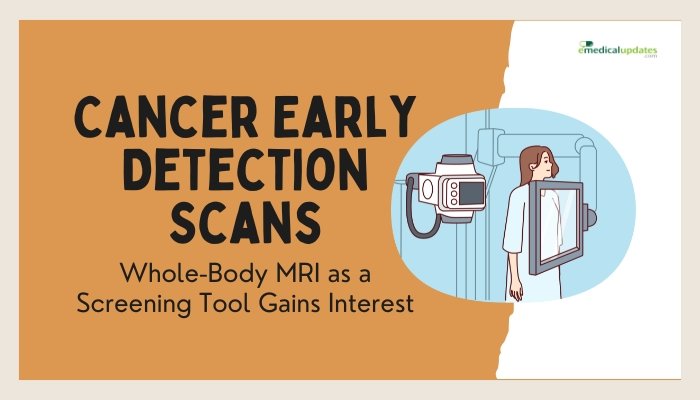Introduction
Detecting cancer at an early stage significantly improves the chances of successful treatment. Traditional screenings—mammograms, colonoscopies, or low-dose CT scans—focus on specific organ systems. Now, a rising trend is whole-body MRI scans, a technique some clinics offer to detect potential tumors anywhere in the body in a single session.
While the approach appeals to those seeking comprehensive assurance, questions remain about cost, overdiagnosis, and the real impact on survival. Below, we examine how whole-body MRI might help in early cancer detection, the considerations for widespread use, and the controversies surrounding its practical benefits.

Why Whole-Body MRI?
Comprehensive Screening
Rather than scheduling multiple separate scans (breast, lung, etc.), a whole-body MRI captures images from head to toe. Proponents claim this method can:
- Spot Hidden Tumors: Particularly in hard-to-reach areas not covered by routine screening.
- Detect Uncommon Cancers: Sarcomas, multiple myeloma, or other rare tumors might be missed by standard protocols.
- Provide Peace of Mind: Some patients prefer a single, broad look at overall health.
MRI Advantages
- No Ionizing Radiation: MRI relies on magnetic fields, avoiding the radiation exposure of CT or X-rays.
- Detailed Soft Tissue Imaging: MRI can excel at highlighting subtle changes in organs, muscle tissue, or connective structures.
Potential Benefits
Early Detection for High-Risk Groups
Individuals with genetic predispositions (e.g., BRCA, Lynch syndrome) or strong family histories might find whole-body MRI appealing. Catching rare or fast-growing tumors earlier could mean simpler treatments and better outcomes.
Tailored Prevention
Early detection, in principle, allows doctors to intervene at a less advanced stage, possibly avoiding aggressive treatments. If cost and accessibility were manageable, it could incorporate into a broader risk-based screening strategy.
Challenges and Controversies
Overdiagnosis and False Positives
- Incidental Findings: Whole-body scans often reveal benign anomalies—cysts, nodules, or lesions that never become harmful. Such “incidentalomas” can lead to unnecessary biopsies or anxiety.
- Psychological Stress: Positive or ambiguous MRI findings without standard guidelines for follow-up can cause confusion and worry.
Cost and Accessibility
Full-body MRI scans can cost thousands of dollars, typically not covered by insurance for routine screening. Many facilities lack capacity to offer them widely. Standard screening, focusing on specific high-risk cancers, remains more accessible.
Limited Evidence for Mortality Reduction
No large-scale, long-term trials exist confirming that routine whole-body MRI scans reduce overall cancer death rates. While more sensitive detection is plausible, real-world benefits on survival—compared to standard, targeted screening—remain unknown.
Practical Guidance
Who Might Consider It?
- High-Risk Individuals: With rare genetic syndromes or strong familial cancer histories, but even then, specialized recommendations usually exist for specific scans.
- Symptomatic or Concerned: Some use it as a one-off check if they have persistent, unexplained symptoms or strong personal reasons.
Informed Decision-Making
Before scheduling a whole-body MRI:
- Discuss with a Physician: Weigh personal risk factors, family history, and typical screening guidelines.
- Understand the Downsides: Potential for follow-up invasive tests, potential anxiety, uncertain insurance coverage.
- Plan Follow-Up: A structured approach to interpret incidental findings or suspicious lesions is critical.
The Future of Whole-Body MRI Screening
As imaging technology advances and specialized AI tools emerge to interpret scans more accurately, the rates of false positives may drop. Large-scale trials might clarify how beneficial these scans are for mortality outcomes in average- or high-risk individuals. Meanwhile, some experts foresee a role in more personalized screening programs, particularly if MRI costs and logistical constraints can be reduced.
Frequently Asked Questions
- Is a whole-body MRI a definitive way to catch all cancers early?
- While comprehensive, no test is perfect. Some cancers may still be too small or hidden to detect, and not all suspicious findings turn out to be malignant.
- Does insurance cover it?
- Typically not for routine screening, as major guidelines don’t yet endorse universal MRI scanning. Coverage is more likely if a doctor suspects a specific problem.
- What about radiation concerns?
- MRI doesn’t use ionizing radiation—so that’s a plus over repeated CT scans.
- Will it replace standard screenings like mammograms or colonoscopies?
- Likely not soon, given cost, limited data on mortality benefit, and well-established protocols for targeted screenings that effectively detect common cancers.
- How long does the scan take, and is it comfortable?
- A whole-body MRI can last 30–60 minutes or more, requiring a patient to remain still. Some experience claustrophobia; sedation or open MRIs might help.
Conclusion
Whole-body MRI scanning for cancer detection sparks both interest and debate. The technology’s ability to potentially spot a range of tumors in a single session is appealing, particularly for high-risk or anxious individuals. Yet concerns about cost, overdiagnosis, and a lack of conclusive evidence regarding improved survival persist. For the average person, targeted screenings remain the standard of care, guided by established guidelines for breast, colon, cervical, and other cancers.
In the years ahead, continuing research, more sophisticated imaging software, and clearer guidelines may refine the role of whole-body MRI in mainstream cancer screening. For now, those considering it as an “all-in-one” approach should weigh the pros and cons carefully, in consultation with healthcare professionals, recognizing that—while advanced technology can reveal a great deal—there’s still no perfect test or guarantee of improved outcomes without careful interpretation and follow-up.
References
-
- Dyrbye T, et al. (2022). “Whole-body MRI for early cancer detection: A systematic review.” Eur Radiol.
-
- Li X, et al. (2021). “Cost-effectiveness of whole-body MRI in cancer screening.” J Med Imaging.
-
- WHO (2023). “Cancer screening guidelines and updates.”
-
- Gulati M, et al. (2020). “The impact of advanced imaging on overdiagnosis in cancer.” Nat Rev Clin Oncol.






